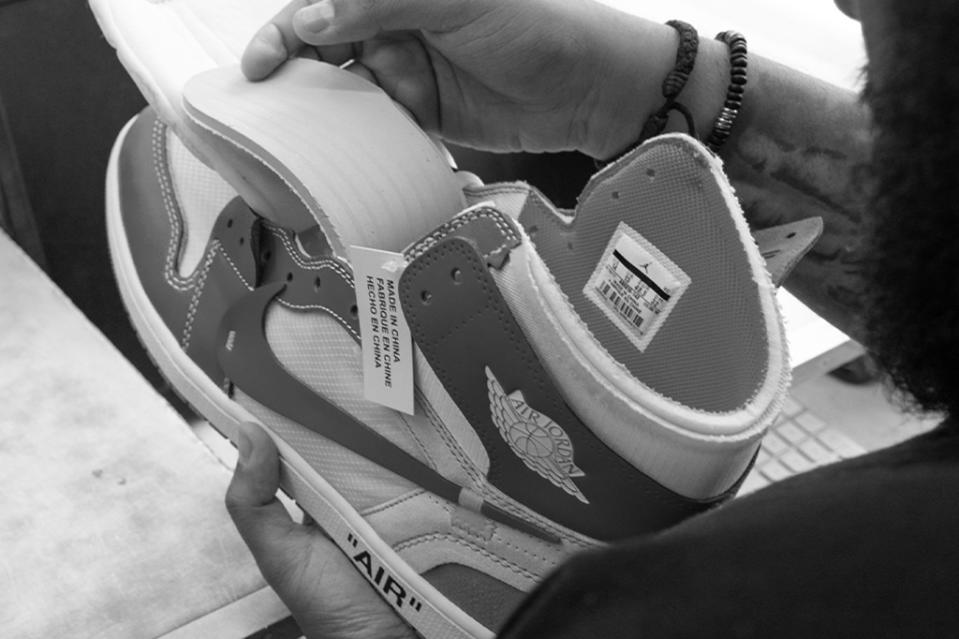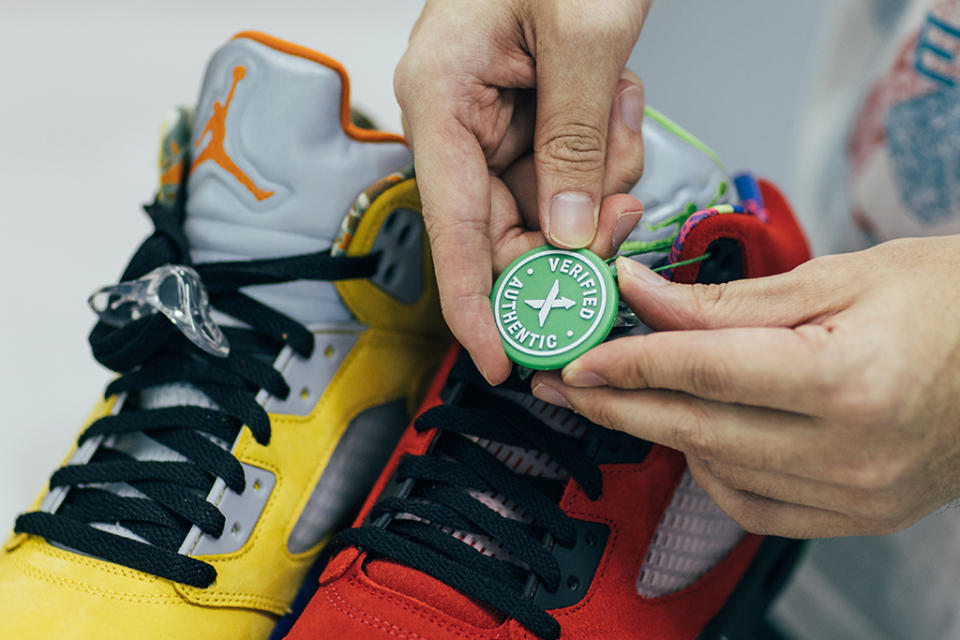StockX, GOAT and Stadium Goods Reveal What It Takes to Become a Sneaker Authenticator

The secondary sneaker market has quickly grown into a multibillion-dollar industry, and given both the demand and the value of what is being bought and sold, authentication is critical.
In fact, spotting fakes is the reason one leading marketplace exists today.
More from Footwear News
Megan Thee Stallion Launches Revlon Makeup Collection on StockX Made for Fellow 'Hot Girls'
The Tokyo Olympics Have Already Impacted Trades on StockX -- Here's What People Are Buying
“The company was actually founded because our co-founder inadvertently purchased a pair of fake Jordans on another marketplace and wanted to solve this problem in the industry,” Jerome Thompson, authentication manager at GOAT, told FN.
Today’s leading secondary sneaker marketplace platforms — including GOAT, StockX and Stadium Goods — have teams of authentication professionals in place to ensure consumers can buy with confidence. And the success of each business is largely tied to its proprietary processes.
StockX, for instance, has more than 300 authenticators across 11 authentication centers and drop-off locations globally. The company confirmed with FN that its team has a 99.95% accuracy rate. As for Stadium Goods, a sneaker will only appear on its website or in store after its authenticity has been vetted. And with GOAT, its ship-to-verify model only works if it can effectively.
Although the secondary sneaker marketplace is still relatively young, leaders in the space have pointed out that the authenticator role has been a cornerstone of the business since its inception. For Stadium Goods, co-founder and co-CEO John McPheters said it has been a foundational element since its 2015 debut. And Thompson noted that Flight Club hired and trained authenticators in New York as far back as 2005.
Despite this, finding the right person for the job often comes with challenges.
“Many of our best incoming candidates come up through existing networks and people who have trained and worked with us for years, although we are always open to engaging with talented and passionate people outside of our network to assess their aptitude in learning the practice,” McPheters said. “The pool of people who have the experience necessary to work in authentication isn’t huge though.”

Courtesy of Stadium Goods
When looking for someone to fill an authenticator role, the three companies have a similar checklist. Being detail-obsessed and having a passion for sneaker culture are prerequisites for all, as well as a willingness to continuously learn.
And the selection process is often rigorous.
“Candidates have to establish their bona fides before they’re even considered for our authentication team,” said Jed Stiller, co-founder and co-CEO Stadium Goods. “Beyond that, we have training guides, an illustrated list of SKUs and a ‘sneaker bible’ — all of which are updated constantly.”
As for StockX, the process to become an authenticator is lengthy, and the candidate is under constant scrutiny.
“Each of our team members goes through a month-long training and onboarding program. We start with formal facilitator-led training and then move into an onboarding phase, which requires new team members to first observe and then work alongside seasoned authenticators,” said Derrick Register, VP of operations at StockX.
GOAT, however, may have the most arduous process of them all.
“[The program] includes months of training before they’re even allowed to authenticate anything on their own. In order to understand the unique markers of authenticity for different SKUs and styles, our authenticators inspect hundreds of shoes per day. At the end of the program, authenticators must pass a set of tests with a 100%. Even after passing, they’re only allowed to specialize in one SKU at a time to truly become an expert,” Thompson explained.
The similarities continue in the companies’ approaches to authentication.
GOAT, for instance, relies on proprietary artificial intelligence and machine learning technology, which is paired with human expertise.
“As the first line of defense, our AI and machine learning is able to detect counterfeit products before they are even able to be listed on our platform,” Thompson said. “The second part of our authentication is our expert team of human authenticators, who rigorously inspect every item through touching, smelling, looking at stitching, laces and boxes and any more markers of authenticity. Our team is constantly mastering the authentication of new styles and SKUs, and our technology collects new data to improve and innovate on our authentication technology.”
McPheters described the Stadium Goods method as “a true 360 approach.”
“It’s tailored specifically to brands and models. Part of staying ahead of counterfeiters is not letting them know what we’re looking for, but suffice to say, we inspect everything from stitching to smell and all points in between,” McPheters said.

Courtesy of StockX
StockX described its approach as “multi-pronged,” pairing expert knowledge and human identification with technology. Also, Register explained that its authenticators have a database of proprietary information with “millions of data points gathered over the company’s five-year history” that is evolving due to real-time updates from authenticators across three different continents.
“While we can’t give away all of the components of our ‘secret sauce,’ our authenticators are trained to go through, on average, 50 different checkpoints to determine authenticity and verify that a sneaker meets our deadstock condition standard,” Register said. “The multi-step authentication process includes tactics such as box construction review to ensure the texture is correct or the tissue paper is the right color, product checks for stitching or gluing inconsistencies and verification of the font color and size tags and receipts, among many other things.”
Although each company has outlined its methodology, because of the consistent newness hitting the market and the sophistication of fakes, the authentication process is never actually complete.
“Continuing education is one of the most critical aspects of this profession,” Register said. “We’re constantly evolving and building on our knowledge through both historical data analysis and forward-looking research and forecasting.”
Because of the constant stream of new releases, GOAT has opted for more of a specialist model.
“Depending on the release, we’ll assign authenticators with specialties and they’ll prepare well in advance to ensure a smooth process,” Thompson said.
Best of Footwear News
Nordstrom's Anniversary Sale Is Now Open to the Public — Shop Our 15 Favorite Shoe Deals
The Brands and Retailers to Support This International Women's Day and Women's History Month
Sign up for FN's Newsletter. For the latest news, follow us on Facebook, Twitter, and Instagram.

